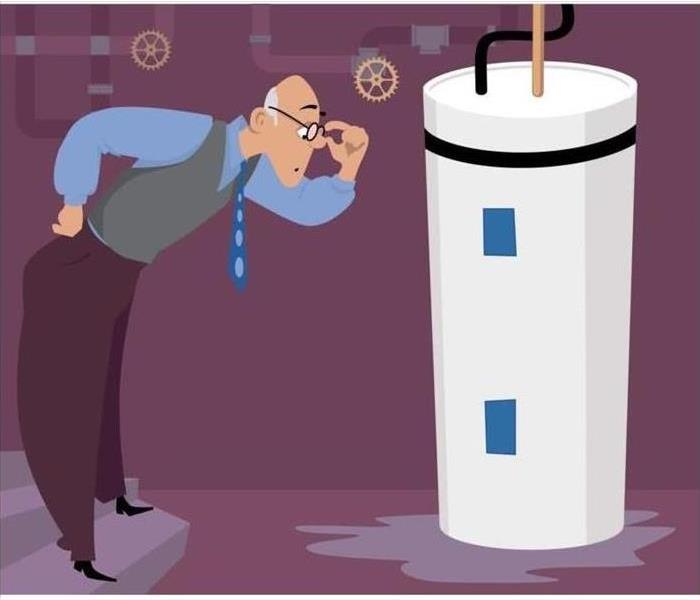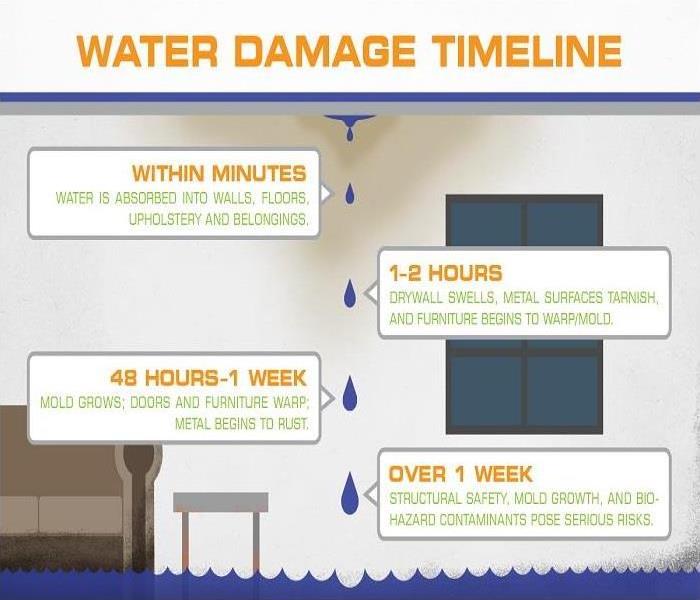Recent Water Damage Posts
5 Tips For After a Toilet Overflows
2/13/2024 (Permalink)
If you’ve had issues with a toilet overflow you may have issues with sewer damage in your Raytown, MO, home. This can be a especially tricky to clean up as sewer waterfalls into the black water category and can require special equipment to ensure it is properly decontaminated and not effecting your property or the individuals within. If you’re experiencing this problem here’s what you should do.
1. Call a Professional
One of the first things that should be done if you have a sewage problem in your home is to contact a local water damage restoration service to assess the damage and begin cleanup and repairs. These professionals can locate the source of the problem which may help determine if the sewage company needs to be contacted as well. As they also have the proper equipment to handle these situations.
2. Wear Proper Safety Gear
It's important to wear proper safety gear any time you are dealing with sewage material to avoid the spread of contaminated material. This includes gloves, coveralls, boots, and masks. This is import to avoid the possibility of contracting any airborne infections or illness.
3. Remove the Water
Once the professionals have arrived and safety gear is in place the professionals can begin the sewer damage restoration. One of the first steps you may see performed is the removal of any floodwater and sewage materials.
4. Dry the Area
Once the water is removed it’s important to thoroughly dry the area. A dehumidifier may be used during this step to begin this process.
5. Decontaminate the Area
After cleaning up a flooded toilet, it’s important to decontaminate the area to ensure that no bacteria remains. This is done to help ensure that the area is safe for use. The professionals overseeing your sewer cleanup may use special cleaners for this job.
When dealing with sewer damage it’s important to contact a professional as quickly as possible. They will have the correct equipment to perform the job safely and can remove the water without causing further contamination to your home. These professionals will also be able to dry and decontaminate the space.
It is important when dealing with a flooded toilet to have a professional examine, clean, and return your property to "Like it Never Even Happened".
Safe Clean Up Of Water Leaking Into Light Fixtures
12/22/2022 (Permalink)
It is not uncommon to find water in light fixtures, or even ceiling damage following a winter with a heavy snow load, or a series of rainstorms. This damage may not always be a major problem, but could definitely develop into such if allowed to continue.
Leaks of this nature may come from a leaking flange around a chimney or vent on the roof that has developed a gap, infiltration by birds or squirrels, or an aging roof. It may also come from an overhead pipe that is leaking due to settling, loosening of joints, or freezing temperatures. Finding and repairing the point where water is getting in is important and should be given priority attention.
How To Handle Cleanup
In order to prevent worsening damage from the water leaking through the roof, immediate cleanup needs to take place.
The attic space should be inspected to see if the insulation has become saturated. Not only can that put an excess load on the ceiling, but it can also develop mold if left alone. It may need to be removed and replaced.
If the leak is from a pipe running above the ceiling, shut the water off as soon as possible to stop the leaking.
If you find water in light fixtures, shut off the electricity to all affected fixtures before attempting to inspect or replace it, and do not turn the electricity back on until certain all water has stopped leaking.
Get Professional Help
Call a water damage cleanup specialist to evaluate any ceiling damage and make a plan for repair. They can determine which materials need to be replaced, ensure that any mold is cleaned and removed, and restore your home to a safe condition.
If you do find water in light fixtures in your home, take it as a severe hint that some repair and cleanup are needed. This will help prevent a worse scenario and help you get your home restored to a safer and healthier condition.
Three Reasons Why Your Toilet Is Leaking
12/15/2022 (Permalink)
A leaking toilet can be a major nuisance, especially when the underlying cause is unknown. If your home has a bathroom leak that goes untreated, the resulting damage can be costly. The following are three possible reasons why your toilet leaks with every flush.
1. Malfunctioning Wax Ring
A common cause of this type of leak is the failure of the wax seal underneath the toilet. When working properly, the wax ring functions as a barrier between the toilet and floor flange to keep water from seeping out. When this wax seal is malfunctioning, it could be that the wax has become dry over time and no longer functions as a barrier, or that the seal was improperly installed with the toilet.
2. Broken Tank Flange
Another potential cause of a leaking toilet is a broken tank flange. If the flange is not properly installed, it can shift out of place and crack under pressure. Because your toilet is a relatively high-traffic area of your home, even a small crack in a tank flange can quickly become a cause for concern and require replacement.
3. Loose Tank
Bathroom leaks that are not pooling on the floor near the base of the toilet can sometimes be traced back to the tank itself. If your toilet is leaking from the tank, but you see no obvious cracks or damage through which water might escape, your tank might just be loose. The connection between the tank and the rest of the toilet can become loose over time and will most likely cost less to repair than to replace entirely.
A leaking toilet can be a headache to deal with on your own. Hiring a professional specializing in water damage repair can help fix existing issues and minimize costly water damage in your bathroom to make it seem "Like it never even happened."
The 3 Essentials of Water-Damage Protection for Your Business
7/18/2022 (Permalink)
Understanding the Three Essentials of Storm Preparedness
The right amount of water in the right place is life-sustaining. When too much water makes its way to the wrong place, it can endanger lives and property. Weather conditions that cause flooding are a primary contributor to commercial property damage. Understanding the three essentials of storm preparedness may help you avoid costly water damage restoration, due to a severe weather event.
Staff Preparation
Preparing your coworkers may prove essential if rising water becomes a reality. Consider the following measures.
Registering with an emergency notification service
Provide your staff with emergency preparedness training by a water emergency specialist
Posting building evacuation routes
Preparing an emergency kit with first aid, water, non-perishable food, flashlights, batteries, towels, and blankets
Choosing an emergency preparedness team leader
With your staff now prepared, you may want to bring your building into compliance with flood-safe practices.
Building Preparation
A few precautions can help you avoid costly water damage to your facility. Winterizing your irrigation backflow preventer in cold winters can prevent broken pipes. It may be useful to equip your sump pump with a battery backup that can allow the pump to run, even in a power outage. Regular cleaning of gutters and storm drains can prevent flood-favorable conditions from developing near your structure. With your staff and facility prepared, the third area to address is your financial protection.
Insurance Coverage
Because water-related damage can result in the destruction of irreplaceable items, insurance coverage is recommended. If your business is located in a high-risk area, you may have been required to purchase a separate flood insurance policy when you purchased the property. Even if your flood risk is low, you may still benefit from a policy that includes coverage for other common types of water damage, such as roof or pipe leaks.
Because water cleanup is generally a disruptive and costly process, you may ultimately be glad you devoted some time to prepare. Taking care of a few preventive measures could prove well worth the trouble by minimizing the impact on your valuable property and your bottom line.
Characteristics of a Category 3 Water Damage
4/21/2022 (Permalink)
Category 3 water damage, also known as black water damage, is the most severe type of water damage that can occur in a building. It is highly contaminated and poses a significant health risk to humans and animals. Here are some of the characteristics of Category 3 water damage:
Source: Category 3 water damage typically comes from sewage backups, toilet overflows, or floodwaters from rivers or streams. The water is highly contaminated with pathogens, bacteria, viruses, and other harmful microorganisms.
Color and odor: Category 3 water is typically dark in color and has a foul odor. It may contain sewage, chemicals, and other hazardous substances.
Damage extent: Category 3 water damage can cause extensive damage to building materials, including drywall, carpeting, insulation, and wood. It can also damage electrical systems, appliances, and other electronics.
Health risks: Exposure to Category 3 water can pose serious health risks, including bacterial infections, viral infections, and other illnesses. Anyone who comes into contact with this water should take precautions to protect themselves.
Cleanup and restoration: Cleaning up after Category 3 water damage requires special precautions and expertise. It is essential to remove all contaminated materials and sanitize the affected area thoroughly to prevent the spread of harmful microorganisms. Professional restoration services are often necessary to fully restore a building after Category 3 water damage.
Municipal Flood Prevention
4/21/2022 (Permalink)
Municipal flood prevention refers to the actions taken by local governments to prevent or mitigate the impact of flooding in urban areas. Floods can cause significant damage to buildings, infrastructure, and public safety, and can be particularly devastating in densely populated urban areas.
There are several measures that municipal governments can take to prevent flooding, including:
Constructing and maintaining stormwater drainage systems - this involves installing storm drains, culverts, and catch basins to channel rainwater away from buildings and streets and prevent flooding.
Building flood walls or levees - these structures can be constructed along rivers, streams, or coastlines to prevent water from overflowing and causing flooding.
Implementing zoning regulations - local governments can regulate the use of land in flood-prone areas to prevent development in these areas and limit the risk of flooding.
Creating green infrastructure - planting trees, constructing rain gardens, and using other green infrastructure techniques can help absorb and slow down stormwater runoff, reducing the risk of flooding.
Educating the public - municipalities can work to educate residents and businesses on flood risks and how to prepare for floods, including developing emergency plans and having adequate flood insurance.
Overall, municipal flood prevention is an important aspect of ensuring public safety and protecting infrastructure in urban areas.
5 Tips to Take After a Toilet Overflow
2/17/2022 (Permalink)
If you’ve had issues with a toilet overflow you may have issues with sewer damage in your Raytown, MO, home. This can be a tricky mess to clean up as sewer waterfalls into the black water category and can require special equipment to ensure it is properly decontaminated. If you’re experiencing this problem here’s what you should do.
1. Call a Professional
One of the first things that should be done if you have a sewage problem in your home is to contact a local water damage restoration service to assess the damage and begin cleanup and repairs. These professionals can locate the source of the problem which may help determine if the sewage company needs to be contacted as well
2. Wear Proper Safety Gear
It's important to wear proper safety gear any time you are dealing with sewage material to avoid the spread of contaminated material. This includes gloves, coveralls, boots, and masks.
3. Remove the Water
Once the professionals have arrived and safety gear is in place the professionals can begin the sewer damage restoration. One of the first steps you may see performed is the removal of any floodwater and sewage materials.
4. Dry the Area
Once the water is removed it’s important to thoroughly dry the area. A dehumidifier may be used during this step.
5. Decontaminate the Area
After cleaning up a flooded toilet, it’s important to decontaminate the area to ensure that no bacteria remain. This is done to help ensure that the area is safe for use. The professionals overseeing your sewer cleanup may use special cleaners for this job.
When dealing with sewer damage it’s important to contact a professional as quickly as possible. They will have the correct equipment to perform the job safely and can remove the water without causing further contamination to your home. These professionals will also be able to dry and decontaminate the space.
Safe Clean Up Of Water Leaking Into Light Fixtures
12/22/2021 (Permalink)
It is not uncommon to find water in light fixtures, or even ceiling damage following a winter with a heavy snow load, or a series of rainstorms. This damage may not always be a major problem, but could definitely develop into such if allowed to continue.
Leaks of this nature may come from a leaking flange around a chimney or vent on the roof which has developed a gap, infiltration by birds or squirrels, or from an aging roof. It may also come from an overhead pipe that is leaking due to settling, loosening of joints, or freezing temperatures. Finding and repairing the point where water is getting in is important and should be given priority attention.
How To Handle Cleanup
In order to prevent worsening damage from the water leaking in through the roof, immediate cleanup needs to take place.
The attic space should be inspected to see if the insulation has become saturated. Not only can that put an excess load on the ceiling, but it can also develop mold if left alone. It may need to be removed and replaced.
If the leak is from a pipe running above the ceiling, be sure to shut the water off as soon as possible to stop the leaking.
If you find water in light fixtures, shut off the electricity to all affected fixtures before attempting to inspect or replace it, and do not turn the electricity back on until certain all water has stopped leaking.
Get Professional Help
Call a water damage cleanup specialist to evaluate any ceiling damage and make a plan for repair. They can determine which materials need to be replaced, ensure that any mold is cleaned and removed, and restore your home to a safe condition.
If you do find water in light fixtures in your home, take it as a serious hint that some repair and cleanup is needed. This will help prevent a worse scenario and help you get your home restored to a safer and healthier condition.
Three Reasons Why Your Toilet Is Leaking
12/15/2021 (Permalink)
A leaking toilet can be a major nuisance, especially when the underlying cause is unknown. If your home has a bathroom leak that goes untreated, the resulting damage can be costly. The following are three possible reasons why your toilet leaks with every flush.
1. Malfunctioning Wax Ring
A common cause of this type of leak is the failure of the wax seal underneath the toilet. When working properly, the wax ring functions as a barrier between the toilet and floor flange to keep water from seeping out. When this wax seal is malfunctioning, it could be that the wax has become dry over time and no longer functions as a barrier, or that the seal was improperly installed with the toilet.
2. Broken Tank Flange
Another potential cause of a leaking toilet is a broken tank flange. If the flange is not properly installed, it can shift out of place and crack under pressure. Because your toilet is a relatively high-traffic area of your home, even a small crack in a tank flange can quickly become a cause for concern and require replacement.
3. Loose Tank
Bathroom leaks that are not pooling on the floor near the base of the toilet can sometimes be traced back to the tank itself. If your toilet is leaking from the tank, but you see no obvious cracks or damage through which water might escape, your tank might just be loose. The connection between the tank and the rest of the toilet can become loose over time and will most likely cost less to repair than to replace entirely.
A leaking toilet can be a headache to deal with on your own. Hiring a professional specializing in water damage repair can help fix existing issues and minimize costly water damage in your bathroom to make it seem "Like it never even happened."
The 3 Essentials of Water-Damage Protection for Your Business
7/17/2021 (Permalink)
Understanding the Three Essentials of Storm Preparedness
The right amount of water in the right place is life-sustaining. When too much water makes its way to the wrong place, it can endanger lives and property. Weather conditions that cause flooding are a primary contributor to commercial property damage. Understanding the three essentials of storm preparedness may help you avoid costly water damage restoration, due to a severe weather event.
Staff Preparation
Preparing your coworkers may prove essential if rising water becomes a reality. Consider the following measures.
Registering with an emergency notification service
Providing your staff with emergency preparedness training by a water emergency specialist
Posting building evacuation routes
Preparing an emergency kit with first aid, water, non-perishable food, flashlights, batteries, towels, and blankets
Choosing an emergency preparedness team leader
With your staff now prepared, you may want to bring your building into compliance with flood-safe practices.
Building Preparation
A few precautions can help you avoid costly water damage to your facility. Winterizing your irrigation backflow preventer in cold winters can prevent broken pipes. It may be useful to equip your sump pump with a battery backup that can allow the pump to run, even in a power outage. Regular cleaning of gutters and storm drains can prevent flood-favorable conditions from developing near your structure. With your staff and facility prepared, the third area to address is your financial protection.
Insurance Coverage
Because water-related damage can result in the destruction of irreplaceable items, insurance coverage is recommended. If your business is located in a high-risk area, you may have been required to purchase a separate flood insurance policy when you purchased the property. Even if your flood risk is low, you may still benefit from a policy that includes coverage for other common types of water damage, such as roof or pipe leaks.
Because water cleanup is generally a disruptive and costly process, you may ultimately be glad you devoted some time to prepare. Taking care of a few preventive measures could prove well worth the trouble by minimizing the impact on your valuable property and your bottom line.
Municipal Flood Prevention
4/21/2021 (Permalink)
It is nearly impossible to control natural factors that lead to high water conditions, but many communities try to take steps to reduce the risk of flooding. Various methods of flood control are regularly practiced, such as
- Reforestation
- Levee, dam, and reservoir construction
- Floodwater diversion, including the use of floodways
Many of the modern methods used in urban and rural areas today have their roots in ancient flood prevention practices.
Sponge Cities
This method is commonly used in China and involves creating an urban environment where water can hold, clean, and then drain water naturally. This ecological approach involves using rainwater for daily living, such as irrigation gardens, flushing toilets, and recharging aquifers.
Flood Plains and Overflow Areas
Vast areas of open land around rivers play vital roles in water management and natural flood protection. Additionally, many city planners include "parks" at lower levels than the surrounding neighborhood. These overflow areas become ponds during storms or heavy rainfall and may save surrounding homes from water-filled basements.
Separate Systems for Storm and Wastewater
Many cities have taken an important step by running separate underground pipe systems for draining rainwater out of the sewer systems. This reduces the burden on wastewater treatment plans and improves the efficiency of functionality. Additionally, city workers take steps to keep sediment, debris, and other items out of the sewer system.
Sustainable Drainage
This refers to replacing non-permeable materials with permeable solutions. For example, a concrete walkway up to the front door won't absorb any water, concrete is non-permeable. However, a decorative stone walkway or a gravel path can absorb water. The more water is absorbed by the ground, the less risk of high water and can help stop flooding.
Flood prevention is a continued study that involves improved efforts. If you want tips on how you can help in prevention efforts before high water situations, talk to a flood remediation professional in your area.
Characteristics of a Category 3 Water Damage
4/21/2021 (Permalink)
Category 3 Water Damage
There are three different levels of damage when it comes to water damages. Category 3 damage is by far the worst. Experts have a way to categorize the different levels of water damage that can occur from floodwater. Category 3 isn’t something you want to ignore or even be around. Here are some traits of this type of water:
- Is contaminated with toxic or pathogenic agents
- Occurs due to backup sewers
- Carries feces, pesticides, or heavy metals
Water from this category is often called black water because of the materials found in it. This situation may not be because of a flaw in your building or home. Blackwater can come in due to sewage problems from the main city line. There are also cases where a toilet overflow could cause category 3 concerns.
If you notice black water at any time in your office or home, make sure you evacuate immediately. Identify where the water is located and how much area is affected. You should contact emergency services and your insurance company as well. Don’t go near the water, and don’t try to clean it up yourself. Instead, get in touch with a reputable commercial water damage restoration specialist. A professional crew will extract all the water with high-powered wet vacuums. Once all the water is gone, the team will dry the floor, walls, ceiling, and any other items. A technician will then, sanitize the space to ensure mold doesn’t grow and that there is no presence of harmful materials.
Category 3 flood water is nothing to take lightly. Follow these guidelines and let a seasoned professional take control.
5 Steps to Take After a Toilet Overflow
2/17/2021 (Permalink)
If you’ve had issues with a toilet overflow you may have issues with sewer damage in your Raytown, MO, home. This can be a tricky mess to clean up as sewer waterfalls into the black water category and can require special equipment to ensure it is properly decontaminated. If you’re experiencing this problem here’s what you should do.
1. Call a Professional
One of the first things that should be done if you have a sewage problem in your home is to contact a local water damage restoration service to assess the damage and begin cleanup and repairs. These professionals can locate the source of the problem which may help determine if the sewage company needs to be contacted as well
2. Wear Proper Safety Gear
It's important to wear proper safety gear any time you are dealing with sewage material to avoid the spread of contaminated material. This includes gloves, coveralls, boots, and masks.
3. Remove the Water
Once the professionals have arrived and safety gear is in place the professionals can begin the sewer damage restoration. One of the first steps you may see performed is the removal of any floodwater and sewage materials.
4. Dry the Area
Once the water is removed it’s important to thoroughly dry the area. A dehumidifier may be used during this step.
5.Decontaminate the Area
After cleaning up a flooded toilet, it’s important to decontaminate the area to ensure that no bacteria remain. This is done to help ensure that the area is safe for use. The professionals overseeing your sewer cleanup may use special cleaners for this job.
When dealing with sewer damage it’s important to contact a professional as quickly as possible. They will have the correct equipment to perform the job safely and can remove the water without causing further contamination to your home. These professionals will also be able to dry and decontaminate the space.
Safe Cleanup if Water Leaking Into Light Fixtures
12/22/2020 (Permalink)
It is not uncommon to find water in light fixtures, or even ceiling damage following a winter with a heavy snow load, or a series of rainstorms. This damage may not always be a major problem, but could definitely develop into such if allowed to continue.
Leaks of this nature may come from a leaking flange around a chimney or vent on the roof which has developed a gap, infiltration by birds or squirrels, or from an aging roof. It may also come from an overhead pipe that is leaking due to settling, loosening of joints, or freezing temperatures. Finding and repairing the point where water is getting in is important and should be given priority attention.
How To Handle Cleanup
In order to prevent worsening damage from the water leaking in through the roof, immediate cleanup needs to take place.
The attic space should be inspected to see if the insulation has become saturated. Not only can that put an excess load on the ceiling, but it can also develop mold if left alone. It may need to be removed and replaced.
If the leak is from a pipe running above the ceiling, be sure to shut the water off as soon as possible to stop the leaking.
If you find water in light fixtures, shut off the electricity to all affected fixtures before attempting to inspect or replace it, and do not turn the electricity back on until certain all water has stopped leaking.
Get Professional Help
Call a water damage cleanup specialist to evaluate any ceiling damage and make a plan for repair. They can determine which materials need to be replaced, ensure that any mold is cleaned and removed, and restore your home to a safe condition.
If you do find water in light fixtures in your home, take it as a serious hint that some repair and cleanup is needed. This will help prevent a worse scenario and help you get your home restored to a safer and healthier condition.
Three Reasons Why Your Toilet is Leaking
12/15/2020 (Permalink)
A leaking toilet can be a major nuisance, especially when the underlying cause is unknown. If your home has a bathroom leak that goes untreated, the resulting damage can be costly. The following are three possible reasons why your toilet leaks with every flush.
1. Malfunctioning Wax Ring
A common cause of this type of leak is the failure of the wax seal underneath the toilet. When working properly, the wax ring functions as a barrier between the toilet and floor flange to keep water from seeping out. When this wax seal is malfunctioning, it could be that the wax has become dry over time and no longer functions as a barrier, or that the seal was improperly installed with the toilet.
2. Broken Tank Flange
Another potential cause of a leaking toilet is a broken tank flange. If the flange is not properly installed, it can shift out of place and crack under pressure. Because your toilet is a relatively high-traffic area of your home, even a small crack in a tank flange can quickly become a cause for concern and require replacement.
3. Loose Tank
Bathroom leaks that are not pooling on the floor near the base of the toilet can sometimes be traced back to the tank itself. If your toilet is leaking from the tank, but you see no obvious cracks or damage through which water might escape, your tank might just be loose. The connection between the tank and the rest of the toilet can become loose over time and will most likely cost less to repair than to replace entirely.
A leaking toilet can be a headache to deal with on your own. Hiring a professional specializing in water damage repair can help fix existing issues and minimize costly water damage in your bathroom to make it seem "Like it never even happened."
The 3 Essentials of Water-Damage Protection for Your Business
7/14/2020 (Permalink)
Understanding the Three Essentials of Storm Preparedness
The right amount of water in the right place is life-sustaining. When too much water makes its way to the wrong place, it can endanger lives and property. Weather conditions that cause flooding are a primary contributor to commercial property damage. Understanding the three essentials of storm preparedness may help you avoid costly water damage restoration, due to a severe weather event.
Staff Preparation
Preparing your coworkers may prove essential if rising water becomes a reality. Consider the following measures.
Registering with an emergency notification service
Providing your staff with emergency preparedness training by a water emergency specialist
Posting building evacuation routes
Preparing an emergency kit with first aid, water, non-perishable food, flashlights, batteries, towels and blankets
Choosing an emergency preparedness team leader
With your staff now prepared, you may want to bring your building into compliance with flood-safe practices.
Building Preparation
A few precautions can help you avoid costly water damage to your facility. Winterizing your irrigation backflow preventer in cold winters can prevent broken pipes. It may be useful to equip your sump pump with a battery backup that can allow the pump to run, even in a power outage. Regular cleaning of gutters and storm drains can prevent flood-favorable conditions from developing near your structure. With your staff and facility prepared, the third area to address is your financial protection.
Insurance Coverage
Because water-related damage can result in destruction of irreplaceable items, insurance coverage is recommended. If your business is located in a high-risk area, you may have been required to purchase a separate flood insurance policy when you purchased the property. Even if your flood risk is low, you may still benefit from a policy that includes coverage for other common types of water damage, such as roof or pipe leaks.
Because water cleanup is generally a disruptive and costly process, you may ultimately be glad you devoted some time to preparation. Taking care of a few preventive measures could prove well worth the trouble by minimizing the impact on your valuable property and your bottom line.
What You Need To Know About Black Water
6/11/2020 (Permalink)
If your home has experienced serious flooding, you’re probably facing extensive water damage. Flood water is considered black water, which means you will need to call in experienced remediation specialists who understand the best practices for restoration to handle the cleanup. This is because black water poses a serious threat.
What Is Black Water?
During a flood, sewers and toilets can overflow, pipes can burst and flood waters can pick up any number of contaminants as they flow through an area. This contamination with feces, urine and other dangerous pollutants are what make flood water “black.” Any stagnant water that has been around long enough to support the growth of harmful bacterial is also considered black.
Why Is It Dangerous?
Contaminated flood water carries dangerous bacteria that can cause humans and animals to become sick. This can occur from accidentally swallowing water or having it come into contact with small wounds or scratches. This includes the flood water saturating possessions after the bulk of the flooding has receded, which is why you should not attempt your own water damage cleanup. Diseases that can be caused by black water include the following:
• Hepatitis
• Gastroenteritis
• Giardia
• Campylobacteriosis
• Typhoid
• Cholera
What Should You Do About It?
Because flood water is considered black water, you shouldn’t attempt to clean your own home after a serious flood. Contact a professional remediation service to handle it for you. After its representatives have assessed the situation, they will begin the process of extracting the remaining water, disinfecting your home and drying it out with industrial equipment. It’s critical this process happens quickly to avoid irreversible damage and mold growth.
When you’re facing water damage after a flood, don’t endanger your family’s health by trying to clean it up yourself. Hire a trained professional who has the knowledge and specialized equipment to handle the damage safely and effectively.
How To Clean Your Building After a Toilet Flood
5/14/2020 (Permalink)
There may not be much that is nastier to deal with than a sewer backup, and your business plan may not include the budget for a sewer cleanup, so, it might be worth looking into flood insurance. Nonetheless, problems can occur and the unexpected can happen, throwing a wrench into the works. Differing from a category 1 or clean water flood, a flooded toilet carries serious contaminants that must be properly dealt with.
How Do You Clean Up Sewer Water
If the water is running clear, stops upon shutoff and is confined to a non-porous bathroom floor, you may be able to mop it up and clean it with detergent and chlorine bleach. If the water has any color to it, is coming from deeper in the drain or is spilling out onto carpeted areas, down a heat duct or is deep enough to be standing you will likely need assistance from a professional sewage cleanup service.
Remove everyone from the area to avoid exposure
Find the water shutoff valve and turn the flow off, if possible
If the water is not running mostly clear, it may be coming from the sewer rather than the supply line
Water must be extracted and cleaned up
Sanitizing and disinfecting must be thoroughly done as sewage can be considered a biohazard
Cleaning and Disinfecting
The sewer line may need to be cleared professionally to unblock the drain. A sewer cleanup service may be necessary to help with that as well as the cleanup. Sewage water is likely to contain bacteria and viruses and it is critical to contain the spill and begin professional a sanitizing process as soon as possible, using industrial disinfectants. Every nook and cranny needs attention. Any rugs, carpets or soft surfaces will likely need to be disposed of.
Employ preventative measures such as regular drain and supply line inspections and enzyme treatments to reduce the risk of flooding. When prevention fails and the need for sewer cleanup occurs, take it seriously to ensure proper restoration.
Possible Reasons Your Toilet May Be Leaking
5/5/2020 (Permalink)
Do You Notice Water Every Time You Flush?
You may have a leaking toilet. A buildup of standing water in your bathroom could lead to water damage, mold or mildew, so it’s best to find the source of the problem as soon as possible- especially in Kansas City, MO. As a complex system, there are multiple reasons this could be happening. Toilets are an everyday necessity, so be sure to take the proper measures to get it back in working order.
Diagnose the Problem
First you need to figure out where the water is leaking from. Clean up as much of the water as you can on both the floor and the toilet itself, so that you can follow the water as it builds again. Try flushing the leaking toilet to jumpstart the process. Usually the water seeps out below the toilet, which will be addressed below, but during this process more unusual causes may present themselves, such as a:
- Damaged toilet tank
- Valve that does not completely close
- Sweaty bowl
- Supply tube that is wobbly or movable
Tighten Up
Water pooling beneath your leaking toilet may be the result of floor bolts that hold the toilet in place becoming loose. Simply remove the protective covers and tighten each one with a wrench. Be sure not to make them too tight, or you could damage the toilet. You should visibly notice the leak stop. If not, there may be a deeper issue.
Wax Gasket
If tightening bolts did not stop your water flow, that probably means that the wax seal on your gasket is dry or cracked. Luckily, it is replaceable. Be sure to shut off the water and drain the toilet before beginning the process. Next, disconnect the water-supply tube and lift the toilet from the floor. You will need to scrape off the old wax before installing the new wax gasket.
Leaking bathrooms are no fun, but that does not mean they should be ignored. Diagnosing the problem is half the job. Feel free to reach out to a professional.
Characteristics of a Category 3 Water Damage
4/21/2020 (Permalink)
Category 3 Water Damage
There are three different levels of damage when it comes to water damages. Category 3 damage is by far the worst. Experts have a way to categorize the different levels of water damage that can occur from flood water. Category 3 isn’t something you want to ignore or even be around. Here are some traits of this type of water:
- Is contaminated with toxic or pathogenic agents
- Occurs due to back-up sewers
- Carries feces, pesticides or heavy metals
Water from this category is often called black water because of materials found in it. This situation may not be because of a flaw in your building or home. Black water can come in due to sewage problems from the main city line. There are also cases where a toilet overflow could cause category 3 concerns.
If you notice black water at any time in your office or home, make sure you evacuate immediately. Identify where the water is located and how much area is affected. You should contact emergency services and your insurance company as well. Don’t go near the water, and don’t try to clean it up yourself. Instead, get in touch with a reputable commercial water damage restoration specialist. A professional crew will extract all the water with high-powered wet vacuums. Once all the water is gone, the team will dry the floor, walls, ceiling and any other items. A technician will then, sanitize the space to ensure mold doesn’t grow and that there is no presence of harmful materials.
Category 3 flood water is nothing to take lightly. Follow these guidelines and let a seasoned professional take control.
Municipal Flood Prevention
4/16/2020 (Permalink)
It is nearly impossible to control natural factors that lead to high water conditions, but many communities try to take steps to reduce the risk of flooding. Various methods of flood control are regularly practiced, such as
- Reforestation
- Levee, dam, and reservoir construction
- Floodwater diversion, including the use of floodways
Many of the modern methods used in urban and rural areas today have their roots in ancient flood prevention practices.
Sponge Cities
This method is commonly used in China and involves creating an urban environment where water can hold, clean, and then drain water naturally. This ecological approach involves using rainwater for daily living, such as irrigation gardens, flushing toilets, and recharging aquifers.
Flood Plains and Overflow Areas
Vast areas of open land around rivers play vital roles in water management and natural flood protection. Additionally, many city planners include "parks" at lower levels than the surrounding neighborhood. These overflow areas become ponds during storms or heavy rainfall and may save surrounding homes from water-filled basements.
Separate Systems for Storm and Wastewater
Many cities have taken an important step by running separate underground pipe systems for draining rainwater out of the sewer systems. This reduces the burden on wastewater treatment plans and improves the efficiency of functionality. Additionally, city workers take steps to keep sediment, debris, and other items out of the sewer system.
Sustainable Drainage
This refers to replacing non-permeable materials with permeable solutions. For example, a concrete walkway up to the front door won't absorb any water, concrete is non-permeable. However, a decorative stone walkway or a gravel path can absorb water. The more water is absorbed by the ground, the less risk of high water and can help stop flooding.
Flood prevention is a continued study that involves improved efforts. If you want tips on how you can help in prevention efforts before high water situations, talk to a flood remediation professional in your area.
5 Steps To Take After a Toilet Overflow
2/17/2020 (Permalink)
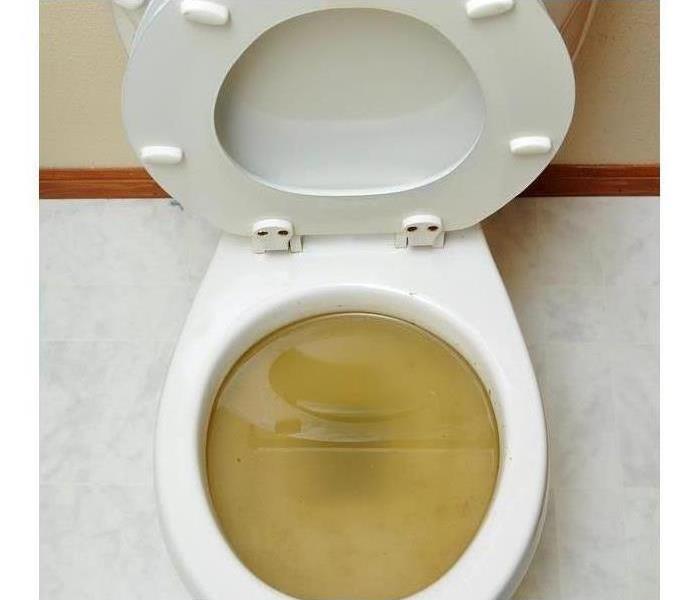 Overflowing broken toilet in Raytown, MO
Overflowing broken toilet in Raytown, MO
5 Steps To Take After a Toilet Overflow
If you’ve had issues with a toilet overflow you may have issues with sewer damage in your Raytown, MO, home. This can be a tricky mess to clean up as sewer water falls into the black water category and can require special equipment to ensure it is properly decontaminated. If you’re experiencing this problem here’s what you should do.
1. Call a Professional
One of the first things that should be done if you have a sewage problem in your home is to contact a local water damage restoration service to asses the damage, and begin cleanup and repairs. These professionals can locate the source of the problem which may help determine if the sewage company needs to be contacted as well
2. Wear Proper Safety Gear
It's important to wear proper safety gear any time you are dealing with sewage material to avoid the spread of contaminated material. This includes gloves, coveralls, boots, and masks.
3. Remove the Water
Once the professionals have arrived and safety gear is in place the professionals can begin the sewer damage restoration. One of the first steps you may see performed is the removal of any flood water and sewage materials.
4. Dry the Area
Once the water is removed it’s important to thoroughly dry the area. A dehumidifier may be used during this step.
5.Decontaminate the Area
After cleaning up a flooded toilet, it’s important to decontaminate the area to ensure that no bacteria remains. This is done to help ensure that the area is safe for use. The professionals overseeing your sewer cleanup may use special cleaners for this job.
When dealing with sewer damage it’s important to contact a professional as quickly as possible. They will have the correct equipment to perform the job safely, and can remove the water without causing further contamination to your home. These professionals will also be able to dry and decontaminate the space.
3 Tips for Mitigating Water Damage After Flooding at Your Business
1/27/2020 (Permalink)
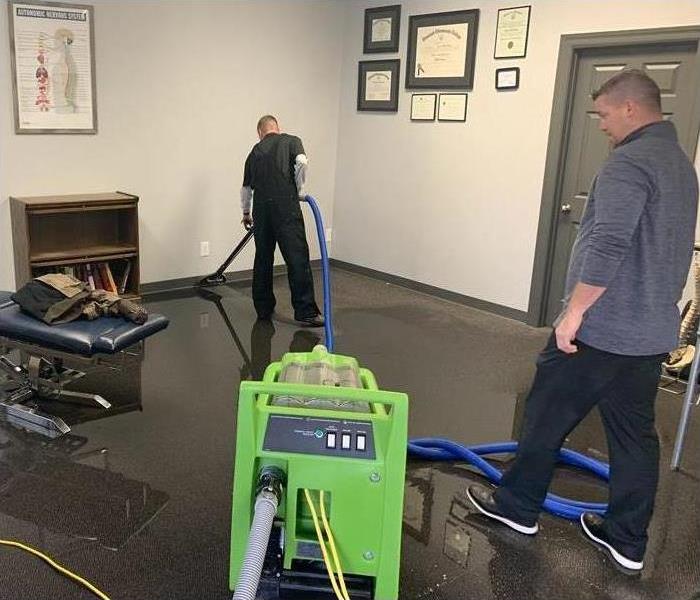 Standing water in a Raytown, MO office
Standing water in a Raytown, MO office
Action To Take To Reduce Flood Damage at Your Business
Indoor or outdoor flooding can cause untold water damage at your Raytown, MO business and leave you with questions about where, to begin with cleanup efforts. While some floods are small, the water can originate from a contaminated source, such as a toilet. However, there are a few actions you can take to reduce flood damage at your business.
1. Connect With a Restoration Service
One of the most effective ways to ensure you can mitigate flooding problems quickly is to connect with a water damage and remediation service as soon as possible. This gives you somewhere to turn when unexpected flooding occurs and can give you peace of mind that the problem can be handled quickly. Trying to find a service during heavy storms that may affect multiple businesses in your area may be difficult, so it may be wise to make a connection beforehand.
2. Turn Off the Building’s Water
If malfunctioning or broken pipes are causing flooding in your building, you may be able to reduce the water flow by turning off the main valve. Note its location early on and if you rent the building, call your landlord as soon as possible so he or she can have the water turned off. If the valve is in a location that is not safe to enter, you may want to call your local public works office for advice.
3. Evacuate the Building
Foot traffic can inhibit water cleanup efforts, especially once a flood cleanup and remediation crew arrives. Consider evacuating both employees and customers in the wake of a flood, as this may help them stay safe as well. You can ask your flood technicians to give you the all-clear once the floodwater is well controlled.
When water damage impacts your Raytown, MO business, the results can be devastating. Knowing how to reduce the flooding until help arrives can help you lower the total cost of restoration and protect your investments.
Safe Cleanup of Water Leaking Into Light Fixtures
12/23/2019 (Permalink)
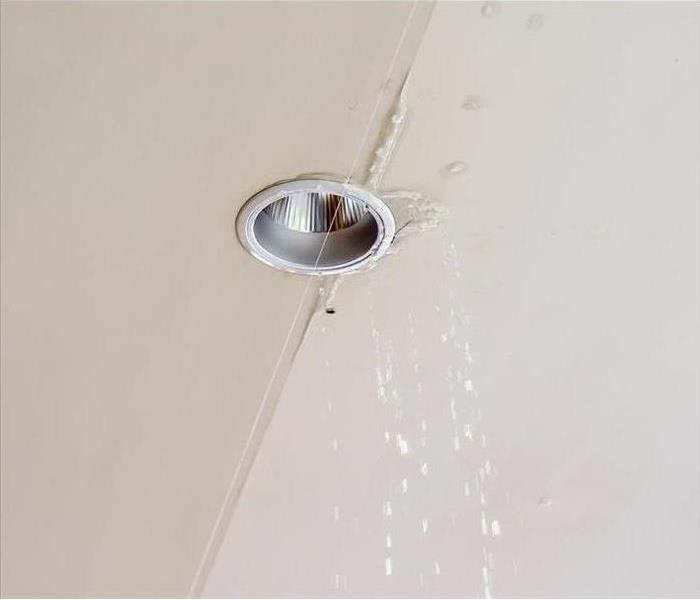 Water damage in light fixture
Water damage in light fixture
Safe Cleanup of Water Leaking Into Light Fixtures
It is not uncommon to find water in light fixtures, or even ceiling damage following a winter with a heavy snow load, or a series of rainstorms. This damage may not always be a major problem, but could definitely develop into such if allowed to continue.
Leaks of this nature may come from a leaking flange around a chimney or vent on the roof which has developed a gap, infiltration by birds or squirrels, or from an aging roof. It may also come from an overhead pipe that is leaking due to settling, loosening of joints or freezing temperatures. Finding and repairing the point where water is getting in is important and should be given priority attention.
How To Handle Cleanup
In order to prevent worsening damage from the water leaking in through the roof, immediate cleanup needs to take place.
The attic space should be inspected to see if the insulation has become saturated. Not only can that put an excess load on the ceiling, but it can also develop mold if left alone. It may need to be removed and replaced.
If the leak is from a pipe running above the ceiling, be sure to shut the water off as soon as possible to stop the leaking.
If you find water in light fixtures, shut off the electricity to all affected fixtures before attempting to inspect or replace it, and do not turn electricity back on until certain all water has stopped leaking.
Get Professional Help
Call a water damage cleanup specialist in Unity Village, MO, to evaluate any ceiling damage and make a plan for repair. They can determine which materials need to be replaced, ensure that any mold is cleaned and removed, and restore your home to a safe condition.
If you do find water in light fixtures in your home, take it as a serious hint that some repair and cleanup is needed. This will help prevent a worse scenario and help you get your home restored to a safer and healthier condition.
4 Tips For Dealing With an Overflowing Toilet
12/10/2019 (Permalink)
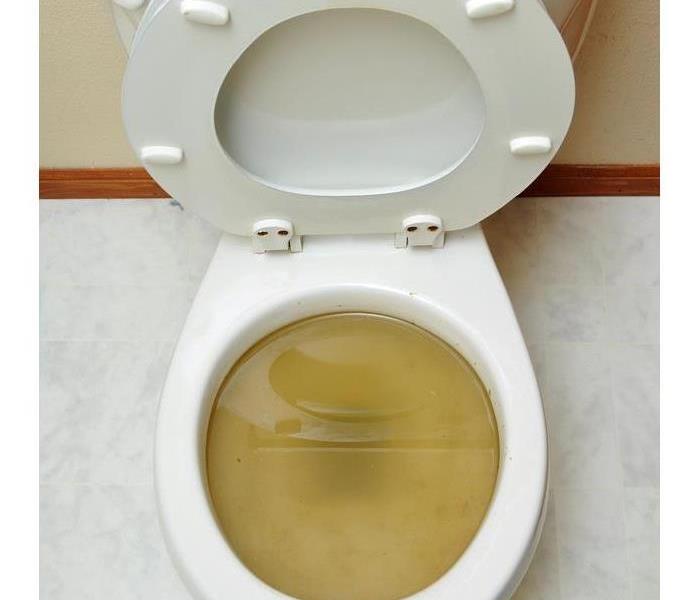 An overflowing toilet can be an annoyance, or it can be a sign of sewer damage
An overflowing toilet can be an annoyance, or it can be a sign of sewer damage
4 Tips For Dealing With an Overflowing Toilet
An overflowing toilet can be an annoyance, or it can be a sign of sewer damage. From clogs to broken pipes, there are a variety of reasons why water might be backing up in your toilet. If you are having this problem in your Kansas City, MO, home, keep the following tips in mind.
1. Stop the Water Source
If the water stops overflowing when you do not flush the toilet, then you might be dealing with a simple clog. However, if it keeps filling up even when you aren’t using it, there might be a more serious problem. In this case, it can be helpful to limit water usage and turn off appliances that could contribute to water backup.
2. Wear Protective Clothing
A flooded toilet often contains category 3 or black water. It can carry significant amounts of bacteria and sewage. Because this can be hazardous to your health, you should avoid the water if you can. If you need to be around it, be sure to wear gloves and other protective gear.
3. Set Aside Wet Items
If your home has sewer damage, you will need to report it to your insurance company who will send an adjuster to inspect your house. If any items have been damaged, you should set these aside as evidence of the damage. Move any items that have not been affected to a dry location.
4. Contain the Area
If the water has not stopped rising, you should block off the bathroom with boards, tarps or other waterproof materials. This will keep the water from spreading to other areas and causing more damage. A sewage company can help with this step.
Because sewer damage often involves contaminated water, it is not recommended that you clean it on your own. Instead, hire a cleanup and restoration company to remove the water and sanitize any affected areas. They can also make needed repairs and salvage damaged belongings.
A Leaking Water Heater Can Be Hazardous
10/16/2019 (Permalink)
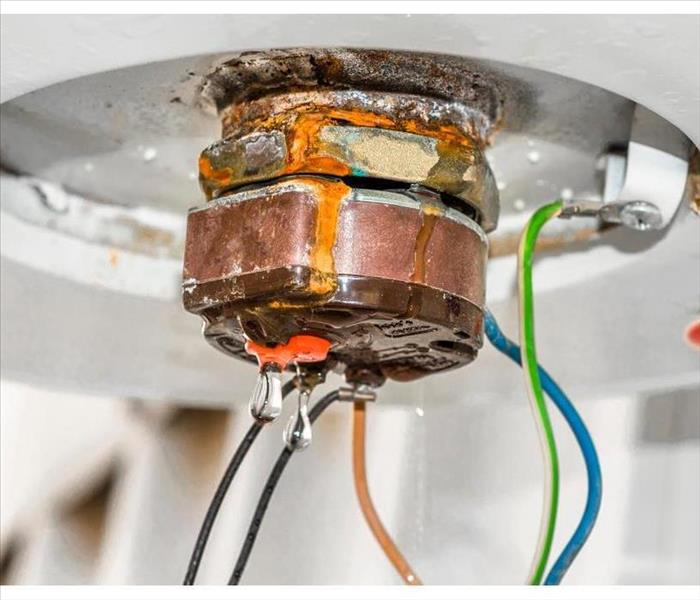 A leaking water heater in a Raytown, MO home
A leaking water heater in a Raytown, MO home
A Faulty Water Heater Can Pose Some of The Following Risks
Most people don’t give their water heater a second thought until they don’t have hot water anymore. If you don’t have any hot water, there’s a good chance that your water heater is leaking. Water heaters are usually located in inconspicuous areas such as a basement, closet or garage, so a leaking water heater may go unnoticed for days, or even weeks, as water builds. A faulty water heater can pose some of the following risks:
1. Electrocution
When you discover that your water heater has been leaking, shut off the power supply via the breaker box. It may seem necessary to get the leak stopped as soon as you notice it. But an electric current could very possibly be traveling through the water if there are other appliances or exposed wiring or power outlets in the area. Stepping in the water could be deadly. Be careful to not get into such a rush to stop the leak that you risk electrocution.
2. Fire
Electrical wiring that’s exposed to water for long periods of time can corrode. This corrosion could cause your electrical system can short-circuit, sparking a fire. This is another reason to shut off the power to the area of the leaking water heater as soon as possible.
3. Burns
Watch out for scalding hot water spewing from the water heater. Water heaters are pressurized and a broken water heater can burst under some circumstances. Turn off the water supply as soon as you can safely access the water supply valve. However, never cap the pressure relief valve; if you do it will eventually explode.
4. Water Damage
Water damage can start almost immediately. Carpet can become soaked and hardwood or laminate flooring can buckle. Water will seep up and through drywall.
5. Mold Growth
Mold growth can start in as little as 24 hours after the introduction of water. Mold spores will not only spread in the area of the failed water heater but could potentially affect your entire home.
If your home in Raytown, MO sustains water damage from a leaking water heater, call on water damage remediation professionals.
Is Your Shower Leaking?
6/10/2019 (Permalink)
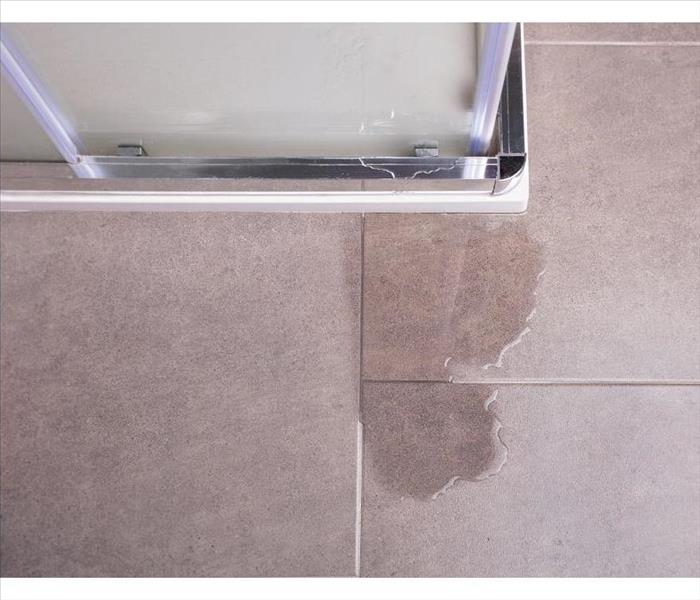 Shower leaking
Shower leaking
Is your shower showing signs of age, or are you moving into a home with a dated bathroom in Raytown, MO? It’s okay to be suspicious of bigger problems such as a bathtub leak. You should make it a priority to inspect for any leaks before water damage or mold moves into your bathroom.
Eliminate All Other Possibilities
First you need to figure out whether the leak is coming from your shower or another water source. If you have observed water on the floor, try to clean up as much of the water as you can so that you can follow the water as it builds again. Try flushing the toilet to see if anything happens underneath it. Run the water and check below the sink. Some possibilities in your bathroom other than a shower or bathtub leak may include:
- Loose bolts beneath your toilet
- Damaged wax gasket in your toilet
- Damaged supply line
- Leaky faucet
Look For Water Damage
Without taking apart your shower, the easiest way to determine a bathroom leak is to look for water damage below your shower. If you go to the floor below your bathroom, do you notice any spots on the ceiling? You can also look for water damage on your baseboards in your bathroom or adjacent rooms. If you see mold, this may indicate you have had a shower or bathtub leak for a while.
Fix the Problem
If you have discovered water damage near your shower, the most likely culprit is a shower pan leak. You will want to call a professional water damage service to inspect it, as the pan is difficult to access. Specialists follow a specific test procedure and can replace your pan for you if needed. Shower pans older than 30 years tend to wear out or may have been cracked during installation.
A shower pan leak can be sneaky, but if you know what you look for, you can sort out the problem before more costly damage takes hold. If you notice water damage in or around your bathroom, get it checked out.
Water Damage Prevention and Cleanup Tips From the Pros
4/16/2019 (Permalink)
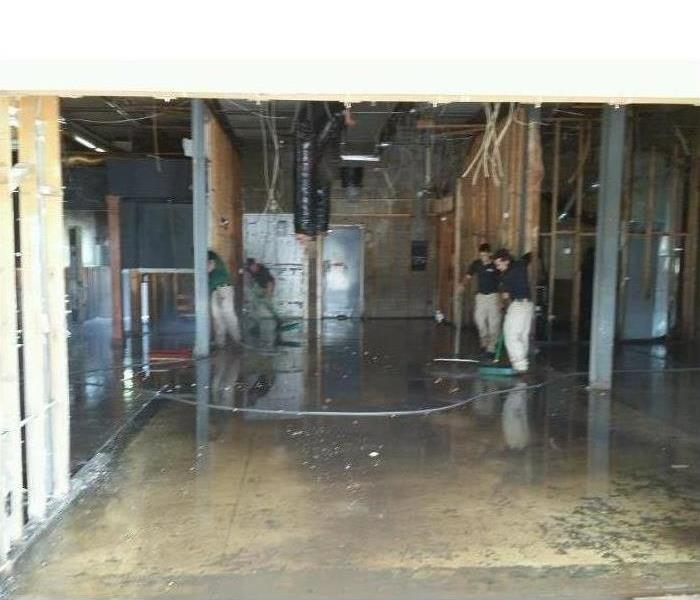 Water removal in a Unity Village, MO building
Water removal in a Unity Village, MO building
The day you walk into work in your Unity Village, MO, office and spot water on the floor or in the walls or ceiling is not a good day at all. Even the most minor water damage can disrupt your business and eat up valuable time and money. There are some things you can do to avoid a pipe burst cleanup. Even if flooding does occur, a reputable water removal company is just a call away to get your office back to normal in no time.
How to Prevent Water Issues
You can’t completely avoid all emergencies all of the time, but there are some tried-and-true tips you can follow to increase your chances of avoiding water cleanup. Some of these include:
- Have a qualified plumber regularly check all the pipes and supply lines in your building.
- Make sure downspouts and rain gutter divert water away from the foundation of your building.
- Inspect the roof annually.
Professional Help
Even after your best efforts, supply line leaking and other issues can lead to flooding. Luckily, a water damage cleanup company can help remove water from the premises. A professional team of technicians has both the experience and skill to correct the problem and help ensure that it doesn’t happen again.
Inspect and Assess
The team will begin by evaluating the cause of the flood and what led to the pipe burst cleanup or other issues. Next, the techs will formulate a plan for cleanup and restoration. The team will also make recommendations on how to fortify your pipes and supply lines.
Cleanup Process
The crew will use commercial-grade extraction machines and dryers to remove all water and dry out the affected area. Just as importantly, the team will sanitize and disinfect the area, which is critical, especially if black water made its way into your building.
Pipe burst cleanup jobs come with extensive damage and messes. Fortunately, you can help guard against these and hire the right professionals.
3 Helpful Tips To Minimize Residential Water Damage
4/4/2019 (Permalink)
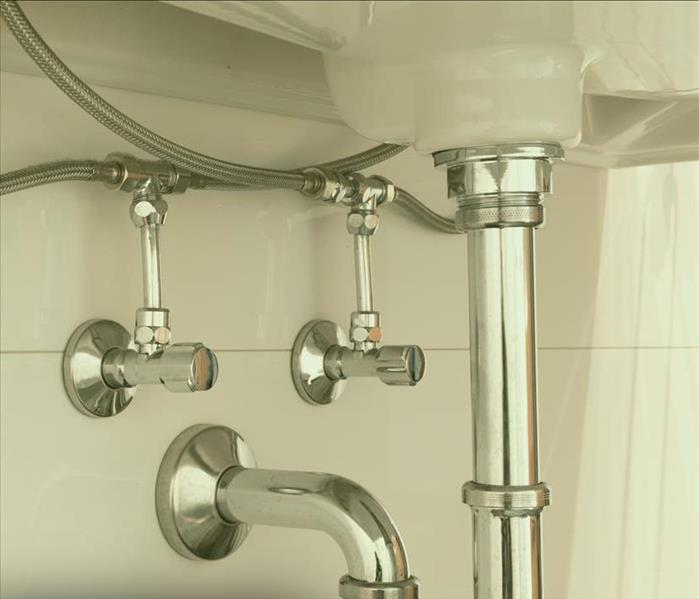 Regurlarly check under sinks and fridges for water buildup
Regurlarly check under sinks and fridges for water buildup
3 Helpful Tips To Minimize Residential Water Damage
Plumbing lines allow convenient access to water in your home. However, a variety of situations can leave your pipes susceptible to damage, increasing the risk of potentially destructive leaks. Fortunately, there are several measures you can take to safeguard your residence with water damage repair services.
1. Protect Your Pipes During the Winter
Frigid winter temperatures can wreak havoc on pipes. Supply lines located in uninsulated rooms or adjacent to exterior walls may be particularly prone to freezing and bursts. To minimize the risk of a broken pipe, you should insulate exposed plumbing structures in your garage, basement and other cold zones inside your residence. You can also circulate warmer air around bathroom and kitchen pipes by opening cabinet doors.
2. Routinely Inspect for Leaks
Water in your home flows to numerous appliances as well as bathroom and kitchen fixtures. Over time, connections can loosen, and supply lines can crack. To help prevent extensive water damage and mold contamination, you should routinely check under your dishwasher and around your washing machine and refrigerator for pooled fluid or dampness and promptly commence any necessary repairs. You should also regularly inspect around toilets and under kitchen and bathroom sinks.
3. Avoid Chemical Drain Cleaners
Clogs are a frustrating plumbing issue that can sometimes be difficult to clear. While it may be tempting to use a chemical solution to perform a pipe cleanup, drain cleaners can corrode or warp both metal and plastic tubes, making them vulnerable to cracks and leaks. To safeguard your home’s water lines, you should use a safer alternative to clear obstructions, such as an auger snake or a plunger.
Like most homeowners in Kansas City, MO, you may rarely worry about a broken pipe and unexpected water in your home. Seepage from damaged lines can, however, cause extensive destruction. Taking proactive steps can help you protect your home’s plumbing infrastructure and avoid a messy cleanup.
Water Heaters
12/31/2018 (Permalink)
SERVPRO of Raytown/East Kansas City has seen countless water heaters cause damage inside homes. A water heater’s useful life varies, depending on the type of water heater, the quality of the unit, and how well it’s been maintained. As long as it’s still heating water sufficiently, without leaks or strange noises, you might still get a few more years of service from it.
A traditional tank-type water has a life span of around 8 to 12 years. An anode rod protects the interior lining by attracting all corrosive particles through a process called electrolysis. When the rod is no longer capable of doing its job. Those particles settle at the bottom of the water tank. This eventually destroys the lining.
A tankless water heater (also called “on-demand” water heaters) can last you up to 20 years, sometimes even more. These water heaters do not continuously work to maintain a supply of hot water, which makes it last longer. Eventually, tankless water heaters will also suffer from corrosion and require replacement.
Make sure to watch for warning signs once your water heater hits it’s second half of life. Some warning signs can be a banging or rumbling noise, tinted hot water, a drop of temperature water, or water pooling around the base of the heater tank can also suggest bad news.
Understanding the Timeline of Water Damage
11/2/2018 (Permalink)
Understanding the Timeline of Water Damage
Flooding and water emergencies don’t wait for regular business hours and neither do we. SERVPRO of Raytown/East Kansas City provides emergency cleaning and restoration services 24 hours a day, 7 days a week—including all holidays.
Flooding and water damage is very invasive. Water quickly spreads throughout your home and gets absorbed into floors, walls, furniture, and more. SERVPRO of Raytown/East Kansas City arrives quickly and starts the water extraction process almost immediately. This immediate response helps to minimize the damage and the cleaning and restoration costs.
Need Emergency Service? Call Us 24/7 SERVPRO of Raytown/East Kansas City 816-737-8776
Here is a Typical Timeline for Water Damage:
Within Minutes:
- Water quickly spreads throughout your property, saturating everything in its path.
- Water is absorbed into walls, floors, upholstery, and belongings.
- Furniture finishes may bleed, causing permanent staining on carpets.
- Photographs, books, and other paper goods start to swell and warp.
Hours 1 - 24:
- Drywall begins to swell and break down.
- Metal surfaces begin to tarnish.
- Furniture begins to swell and crack.
- Dyes and inks from cloth and paper goods spread and stain.
- A musty odor appears.
48 Hours to 1 Week:
- Mold and mildew may grow and spread.
- Doors, windows, and studs swell and warp.
- Metal begins to rust and corrode.
- Furniture warps and shows signs of mold.
- Paint begins to blister.
- Wood flooring swells and warps.
- Serious biohazard contamination is possible.
More Than 1 Week:
- Restoration time and cost increase dramatically; replacing contaminated materials and structural rebuilding may be extensive.
- Structural safety, mold growth, and biohazard contaminants pose serious risks to occupants.
About SERVPRO of Raytown/East Kansas City
SERVPRO of Raytown/East Kansas City specializes in the cleanup and restoration of residential and commercial property after a fire, smoke or water damage event. Our staff is highly trained in property damage restoration. From initial and ongoing training at SERVPRO’s corporate training facility to regular IICRC-industry certification, rest assured our staff is equipped with the knowledge to restore your property.
Water Damage Requires a Quick Response
10/24/2018 (Permalink)
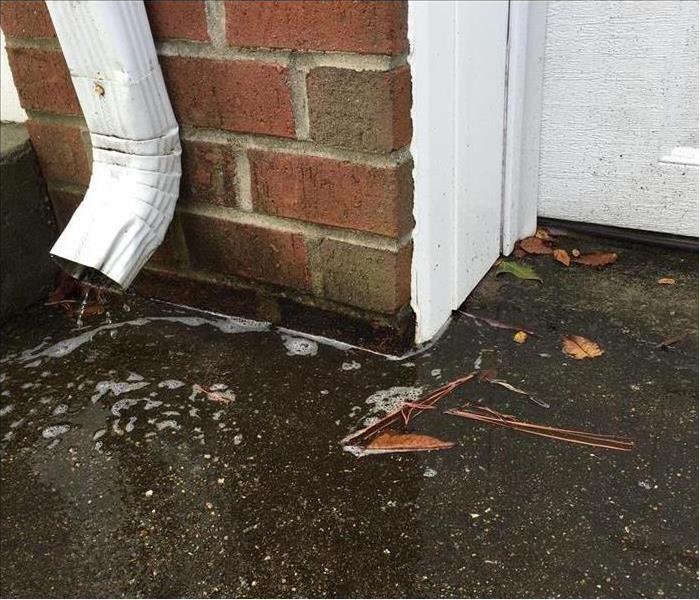
Floods, rainstorms and tornadoes can become massive water damage threats to businesses during the often-stormy spring and summer months. Facilities plagued with such water woes this season must take quick action.
You won’t see it emphasized on the nightly news when a disaster hits, but water damage can represent potentially huge disasters for businesses and building owners and operators.
Water damage can mean much more to a business than just wet and soggy carpets. There are other common, more significant problems businesses face when water wreaks havoc on property, such as indoor air quality problems. Mold and mildew grow rapidly in damp, humid environments, leaving behind an unpleasant smell that permeates floors, walls and ceilings, even after the water has been removed. It also can create health problems for employees.
Damage to the building’s structure and foundation also can be an issue. When water sits inside a building for a period of time, the walls, ceilings and floors absorb the water, which threatens the overall structural integrity of the building and creates an unsafe environment. Total reconstruction of the building often becomes the only option.
Another major threat to business is the loss of expensive equipment, which often can cost hundreds of thousands of dollars to replace.
To minimize water damage, there are two critical steps that need to be taken:
- Act fast to assess the situation; and
- Control the environment within the building.
Act Fast and Call an Expert
The absolute first step to take is fast action. Damage resulting from water and flooding is very progressive. The longer the water flows or wet conditions are allowed to exist, the greater the recovery problem becomes. A water damage consultant must come in immediately to survey the situation.
In a typical scenario, a team of water damage recovery professionals is dispatched to the site to perform a thorough inspection and fully determine the extent of the damage. A disaster reclamation partner also will develop an intense restoration plan and determine which items are worth restoring and which are better replaced.
You can’t always save everything by drying, but you can save a tremendous amount. It’s not unusual to save between 30 and 70 percent of the cost needed to reconstruct a facility.
Controlling the Interior Environment
Another key in limiting water damage is to quickly control three conditions of a building’s atmosphere: relative humidity, temperature and air circulation. Fast, effective action at this point will generally confine the damage to the area that was directly affected by the water damage event.
The most effective way to control these conditions in a high-moisture environment, especially a large facility, is to employ professional disaster drying that combines air movers with desiccant dehumidifiers.
Disaster drying often eliminates the need to rip out and replace walls, carpet, floor covering, hardwood floors and the building structure, which can be a huge expense. On top of that, you preclude the odors and staining caused by mold and mildew. These problems can come back to haunt you weeks later in a superficially dried building.
The Desiccant Way
When a facility has been severely water damaged, you need high volume desiccant dehumidifiers. Some larger desiccant dehumidifiers can pull 800 gallons of water out of a building in one day, compared to the typical small refrigeration units that remove about five gallons a day.
Many people are surprised that “solid” materials such as concrete and hard woods absorb moisture. But they do and rather quickly.
Getting the water back involves a phenomenon called migration. Migration is the tendency for water molecules to move toward a low vapor pressure. When a room is filled with very dry air, which has low vapor pressure, trapped water migrates outward and is evaporated from the surface by the dry air. As the air in the room fills with water vapor, we expel it. We then replace it with more dry air and the process continues.
It’s also essential to be sure the equipment being used is sized right. Inappropriately sized drying equipment can lead to insufficient drying and long-term problems with the building. Only large-volume dehumidifiers could provide the massive drying power needed to dry the space quickly and thoroughly.
Best Defense: A Disaster Recovery Plan
To minimize damage and costs, companies need to think ahead about what to do in a water damage event and contact a water damage expert to create a Disaster Recovery Plan (DRP).
A DRP can limit the extent of water damage occurrences by defining and prioritizing the recovery of areas within a facility and stating immediate next steps. Proper planning and fast action are most certainly the best defense to preventing a catastrophic water damage event.
Immediate Steps to Take if You Suffer From Water Damage
9/18/2018 (Permalink)
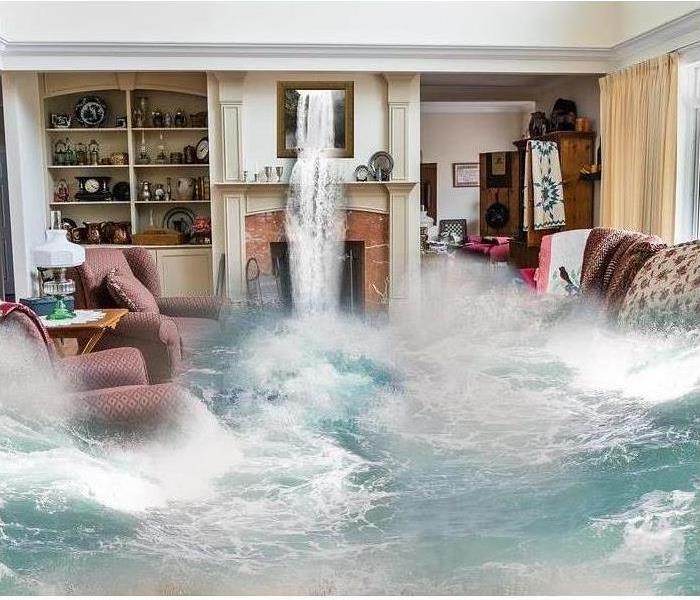 Follow these tips so you can be prepared.
Follow these tips so you can be prepared.
Let’s face it, water damage is threatening to your property’s value and can cause some serious, well damage. Whether you’re facing a storm; a flood; leaks from a weakened roof, HVAC or busted pipes; or experience overflowing appliances, water damage can wreak havoc in an array of emergency situations. To prevent further damage and to increase chances of salvation, it is critical to act quickly within the first 24 hours. Considering you have safely evacuated the premises and safety officials have declared it safe, follow these steps to immediately rectify your business from water damage.
Avoid Additional Risks
Upon returning to your property, survey the premises and document any visible structural damage that may further endanger you and your property. Look for signs of warping, loosened or cracked foundation elements, and holes. If safety officials haven’t done so already, contact utility companies to cease all water and electrical sources. Even if the power is still out upon your return, physically turn off the main power line and individual fuses to avoid risk of electrocution should the power be reactivated.
Document Everything
While surveying your property, take photos and document all damages. Digital photos will allow you to properly store, back-up and transfer files quickly and conveniently. Be sure to document all damages prior to removing any water or starting on any repairs; otherwise, you risk decreasing the extent of your insurance coverage.
Contact your Insurance Provider
Contacting your insurance provider is critical immediately following water damage and your return to the property. Your insurance provider will be able to assess the situation, file a claim, determine whether or not the damage is severe enough to send an adjuster, and provide invaluable next steps. They will also ask for the documentation you’ve collected so it’s important to have that readily available. Pro Tip: if government authorities have declared your region a ‘disaster area’, property owners may have access to increased resources, services and financial assistance.
Secure the Property
Place board over broken windows, fasten tarps, and carryout other measures to avoid further leaks and water damage. Be sure to document all of your efforts to secure your property from further damage. If these precautionary steps are not taken and something else happens, additional damages may not be covered by your insurance provider.
Mitigate Mold Damage
It only takes 24-48 hours for mold to develop following a flood or water damage. If items have been wet for less than 48 hours, they may be salvageable. Remove wet contents such as carpeting and furniture as soon as possible. If an item has been exposed longer than 48 hours, it may be harder and more expensive to salvage. If possible, you can start the drying out process within 24 hours and eliminate mold and mildew growth by:
- Removing wet furniture or lifting it off of carpet
- Place aluminum foil or other carpet separators on furniture to prevent carpet stains
- Remove and hang area rugs to dry
- Use fans and dehumidifiers to dry out wet areas
- Turn air conditioning on to help remove humidity and speed the drying process
Contact A Professional Restoration Service
If any amounts of water need more than a mop and you’ve followed the immediate steps to secure your business, water removal may require professional attention. SERVPRO of Raytown/East Kansas City has the expertise, training and equipment to quickly remedy water damages and help your business get back to working order faster. Give SERVPRO of Raytown/East Kansas City a call at 816-737-8776.
How to Handle a Toilet Overflow
8/30/2018 (Permalink)
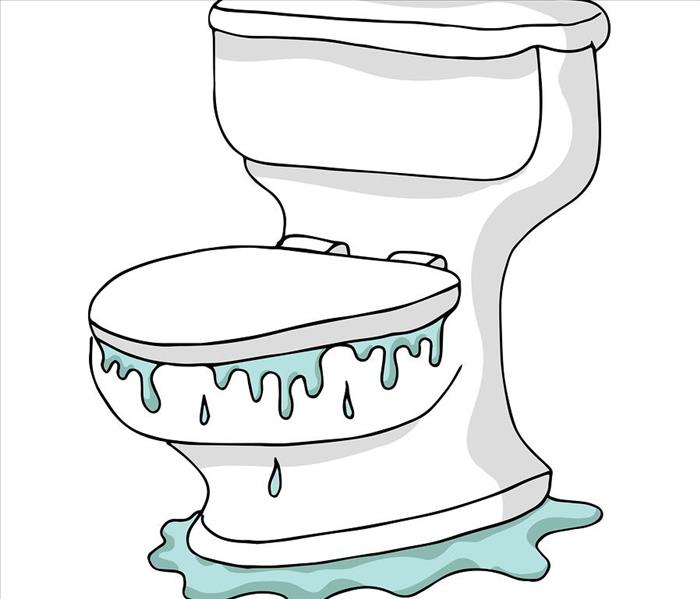 For more information, please visit us at http://www.SERVPROraytowneastkansascity.com
For more information, please visit us at http://www.SERVPROraytowneastkansascity.com
You should act quickly after a toilet overflows to limit the secondary damage caused by a sewage leak. Depending on what category of water is involved, the risk of sewer damage goes up. If the leak is large and involves black water, you may need to call a sewage company that provides restoration services in Raytown/East Kansas City, MO, as well as a plumber. Find out about the three different categories of water and simple steps you can take to fix a flooded toilet and clean up the mess.
There are three categories of water in a leak scenario:
1. Clean water: Clean water should simply be removed and the area of the leak should be thoroughly dried.
2. Gray water: Gray water includes the water from appliances such as washing machines and toilet water that only contains urine. Cleaning and disinfection are important steps.
3. Black water: Black water contains contaminants with microbes and may pose a threat of infection to individuals with compromised immune systems. Leaks involving black water should be dried and disinfected as soon as possible, ideally within 24 hours.
As soon as you realize that a toilet is overflowing, you should try to see if you can handle the clog on your own with a plunger. If you cannot, minimize the extent of a leak by using towels to prevent water from spreading and contact a plumber. Once a plumber solves the underlying issue, it is up to you to limit the extent of secondary sewer damage or call on experts to completely restore the affected area.
Depending on the extent of the leak caused by a flooded toilet, you may want to contact a sewage company that specializes in restoration. Look for a cleaning and restoration service that specializes in sewer damage in Raytown/East Kansas City, MO, if you are concerned about lingering unwanted smells or the risk of mold.
Water Damage Do's & Don'ts
8/9/2018 (Permalink)
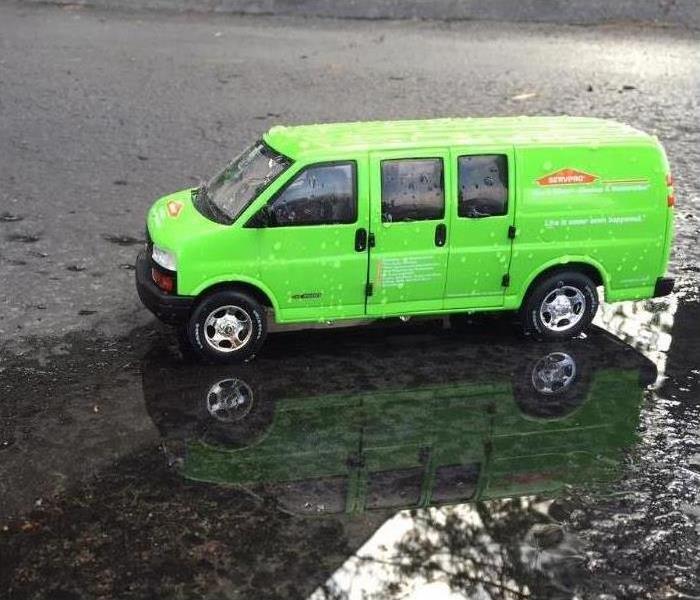 #WaterDamage
#WaterDamage
No one wants to come home to a flooded basement or to wake up to the sound of a broken pipe spraying water on valuable furniture and household possessions. However, the possibility of water damage occurring in your Raytown/East Kansas City home is very real. Whether it is a pipe burst or a weather-related issue, it is important to arm yourself with some basic knowledge to deal with this type of emergency before it happens.
Here are a few tips to help in the event of water damage in your Missouri home:
- First, ascertain whether it safe to stay in the house.
- Make sure there are no active electrical devices or outlets immersed in or near the water.
- Note that wet floors are slippery and “slip and fall” hazards are some of the most prevalent concerns.
- Keep in mind that wet materials can be VERY heavy.
- Have your plumber’s phone number ready and available.
- Contact your SERVPRO Professional at (816) 737-8776 for complete restoration.
While waiting for your SERVPRO Professional to reach your location, here is what you CAN do:
- Shut off the water
- Remove excess water by mopping and blotting.
- Wipe excess water from wood furniture after removal of lamps and tabletop items.
- Remove and prop wet upholstery and cushions.
- Place aluminum foil or wood blocks between furniture legs and wet carpeting.
- Turn air condition on for maximum drying in the Summer.
- Remove colored rugs from wet carpeting.
- Remove art objects and other prized possessions to a safe, dry place
- Gather loose items from floors.
What NOT to do After Flooding:
- Don't leave wet fabrics in place. Hang furs and leather goods.
- Don't leave books, magazines or other colored items on wet carpet or floors.
Being Prepared for April Showers' in your House
4/3/2018 (Permalink)
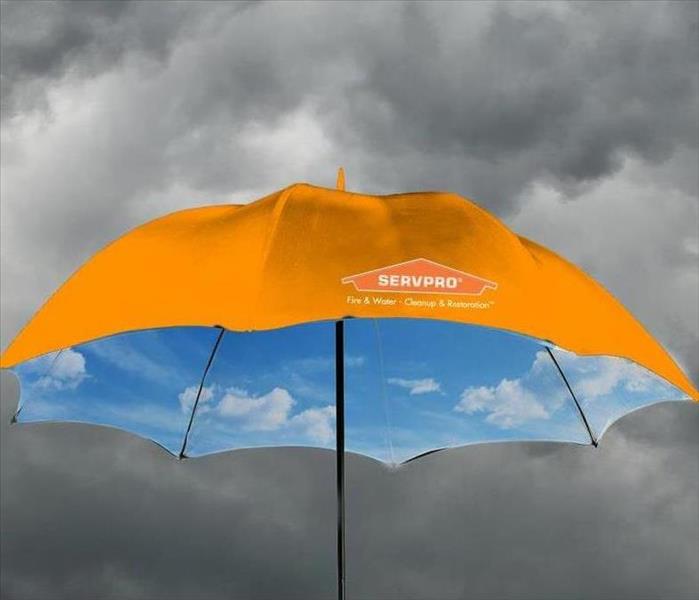 Call us today with any water damage - 816-737-8776
Call us today with any water damage - 816-737-8776
Living in the Midwest can be quite exasperating at times; with having no beach within a 500 mile radius, to our inconsistency to decide what season it is. We never know what to expect so we have to be prepared for the unexpected.
Here at SERVPRO, we are prepared to clean up your house fire on Monday - to your flooded basement on Wednesday. Here are some helpful tips to keep your house safe before and after experiencing inconvenient crisis.
Important Warnings about Water Damage:
- Do not go into rooms with standing water if the electricity is still on!
- Do not use electrical appliances while on wet surfaces.
- Do not use any ordinary vacuum to remove any water.
- Do not lift tacked down carpet without professional help.
After Experiencing Water Damage:
- Use fans to circulate the air and assist with drying.
- Use dehumidifiers if available.
- Remove as much water as possible by mopping and blotting.
- Wipe furniture dry.
- Lift draperies off carpet, loop through a coat hanger, and place the hanger on the draper rod.
- Prop up wet furniture cushions for even drying and place small wood blocks under furniture legs.
- Remove wet area rugs or other floor coverings.
- Open furniture drawers, closet doors and luggage to enhance drying.
- Move photos, paintings, and art objects to a safe, dry location.
- Remove wet fabrics and dry them as soon as possible. Hang furs and leather goods to dry separately at room temperature.
- Do not remove damp books from shelves. Leave tight to prevent pages from rippling.
- Control interior temperatures with heat or air conditioning. Keep interior temperatures between 70 and 80 degrees.
5 Steps to be Prepared for Water Damage
1/2/2018 (Permalink)
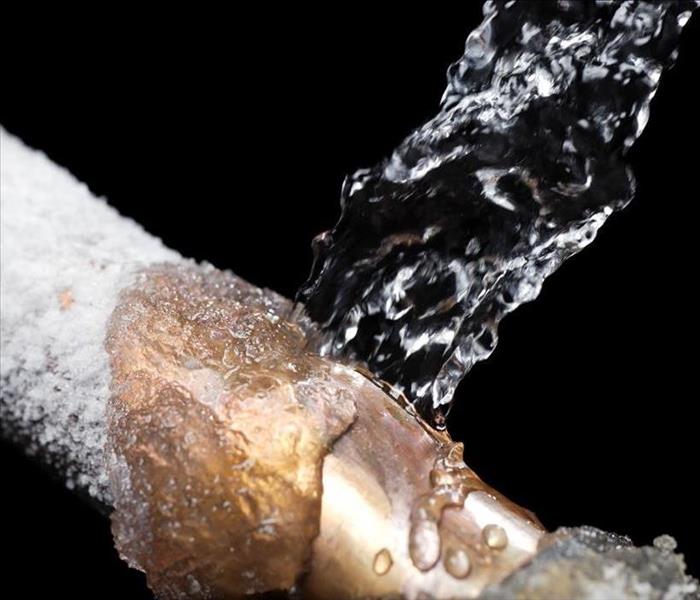 Call SERVPRO of Raytown/ East Kansas City today 816-737-8776
Call SERVPRO of Raytown/ East Kansas City today 816-737-8776
Most water damage that happens to your home is uncontrollable and unpredictable. It could potentially cost you thousands of dollars. When the water starts coming into your home, there is not much you can do to stop it but there is a couple things you can do to prepare for it. Here are a few steps you can take so you can be prepared for the worst.
Step 1: Stop the Source of the Water
If it is possible, stop the water at its source. If it has to do with your plumbing then turn off your water line as soon as possible. This will help with decreasing the amount of damage.
When the flooding occurs from storm water, there is no stopping a storm but you can try and divert the water away from your home by blocking entry points.
Step 2: Think Safety
If it safe, then shut off all electrical sources by turning the circuit breakers or unplug devices. Water and electricity don’t mix, remember that. Make sure everyone, including children, are away from standing water.
Step 3: Protect Your Possessions
Try and remove or raise your furniture from flood water. Water soaked furniture begin to mold very quick and you the last thing you will want is to throw away all of your belongings after a flood. Protect the things that are irreplaceable rather then carpet and other flooring.
Step 4: Contact Your Insurance Company
Now is the time to call your insurance and see how they will approach the water remediation. All insurance companies have professionals who specialize in this kind of emergency so they will have the best people to restore your home back to normal. Do not try to remove the water by yourself. You can just end up cause more damage.
Step 5: Work With the Professionals
When you are choosing a company to perform your water remediation; you need to compare everyone highs and lows. Make sure they have good reviews and are available at your earliest request. SERVPRO of Raytown/East Kansas City is highly dependable and will exceed your expectations for your water remediation.
Tips to Avoid Freezing Pipes
11/3/2017 (Permalink)
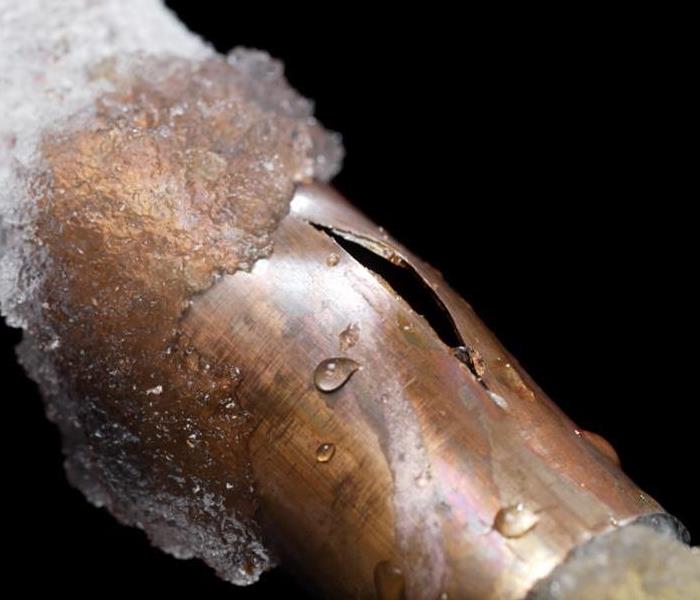 Don't let frozen pipes flood your life with unexpected problems!
Don't let frozen pipes flood your life with unexpected problems!
Why Pipe Freezing is a Problem
Water has a unique property in it that expands as it freezes. This expansion puts tremendous pressure on whatever is containing it, including metal or plastic pipes. No matter the “strength” of a container, expanding water can cause pipes to break. Pipes that freeze most frequently are those that are exposed to severe cold, like outdoor hose bibs, swimming pool supply lines, water sprinkler lines, and water supply pipes in unheated interior areas like basements and crawl spaces, attics, garages, or kitchen cabinets. Pipes that run against exterior walls that have little or no insulation are also subject to freezing.
If your pipes do freeze and cause damage to your home or business, STAY CALM AND CALL SERVPRO Raytown / East Kansas City, we can make it “Like it never even happened.®”
During a freeze, Take Preventative Action
- Keep garage doors closed if there are water supply lines in the garage.
- Open kitchen and bathroom cabinet doors to allow warmer air to circulate around the plumbing. Be sure to move any harmful cleaners and household chemicals up out of the reach of children.
- When the weather is very cold outside, let the cold water drip from the faucet served by exposed pipes. Running water through the pipe - even at a trickle - helps prevent pipes from freezing.
- Keep the thermostat set to the same temperature both during the day and at night. By temporarily suspending the use of lower nighttime temperatures, you may incur a higher heating bill, but you can prevent a much more costly repair job if pipes freeze and burst.
- If you will be going away during cold weather, leave the heat on in your home, set to a temperature no lower than 55°F.
To Thaw Frozen Pipes
- If you turn on a faucet and only a trickle comes out, suspect a frozen pipe. Likely places for frozen pipes include against exterior walls or where your water service enters your home through the foundation.
- Keep the faucet open. As you treat the frozen pipe and the frozen area begins to melt, water will begin to flow through the frozen area. Running water through the pipe will help melt ice in the pipe.
- Apply heat to the section of pipe using an electrical heating pad wrapped around the pipe, an electric hair dryer, a portable space heater (kept away from flammable materials), or by wrapping pipes in towels soaked by hot water. Do not use a blowtorch, kerosene or propane heater, charcoal stove, or other open flame device.
- Apply heat until full water pressure is restored. If you are unable to locate the frozen area, if the frozen area is not accessible, or if you can not thaw the pipe, call a licensed plumber.
Check all other faucets in your home to find out if you have additional frozen pipes. If one pipe freezes, others may freeze, too.
How SERVPRO Assesses Flood Damage After a Dishwasher Breakdown
10/25/2017 (Permalink)
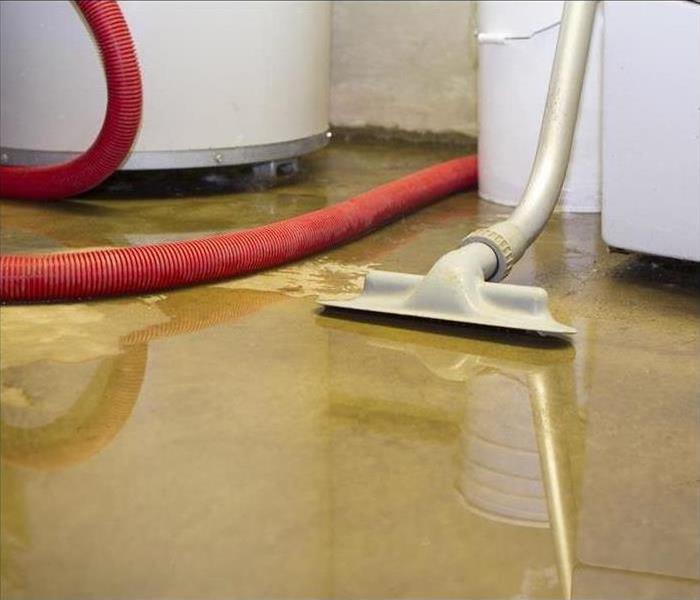 Raytown/East Kansas City relies on SERVPRO for cleanup and water removal.
Raytown/East Kansas City relies on SERVPRO for cleanup and water removal.
SERVPRO's Array of Measuring Devices Ensures a Dry Home Post Flooding
Dishwashers are a welcome addition to many households. After all, who does not love being able to simply rinse the dishes, set the cycle, and let the machine do the work? It is very convenient. However, like any other appliance, a dishwasher might malfunction, and a dishwasher breakdown often equals a flood of water in your kitchen.
Flood damage to your Raytown/East Kansas City home can be a serious cause for concern. A dishwasher might cause a surprisingly large flood in your kitchen, so naturally, you want to get that cleaned up as quickly as possible to mitigate any further damage. That is why we recommend you put in a call to SERVPRO at once -We’re Faster To Any Size Disaster.
An essential element of our job is assessing the damage to your home. A thorough assessment lets our experts know how much moisture is present, which is vital information that we need to decide upon the best course of action.
A visual inspection is an important first start, but of course, that is only one part of the process. Our teams come prepared with a range of powerful equipment to help us assess the flood damage to your home:
A moisture sensor to help us ascertain how deeply water has penetrated into soft materials. The sensor displays a blinking light and makes an audible beep when moisture is present, and this allows us to measure the extent of the damage. We have other models that work silently.
A moisture meter to help us measure how much moisture is in any structure. Meters are useful for testing the damp content of every part surrounding your dishwasher including not only the floor but also walls, wall insulation, cabinets, and rugs or carpets. Do not worry if you have a wooden floor. Our SERVPRO experts also come equipped with penetrating moisture meters that can be used to take a reading under wood flooring or even inside the wall. Our technicians calibrate the instrument to suit the material that we are testing.
Thermo-hygrometers. Thermo-hygrometers measure the temperature and the relative humidity in your kitchen. Our technicians use these readings to determine the extent of the water damage. This is usually used after the water has been removed, a verification that a standard RH has been attained.
A complete evaluation of the situation assists us in drawing up an effective individual drying plan for your kitchen. We monitor moisture and humidity throughout the drying process so you can rest assured your kitchen is at optimum dryness and humidity before we call the job done. We can also provide documentation to your insurance company.
Why Water Damage Restoration Services are Imperative After a Flood
9/18/2017 (Permalink)
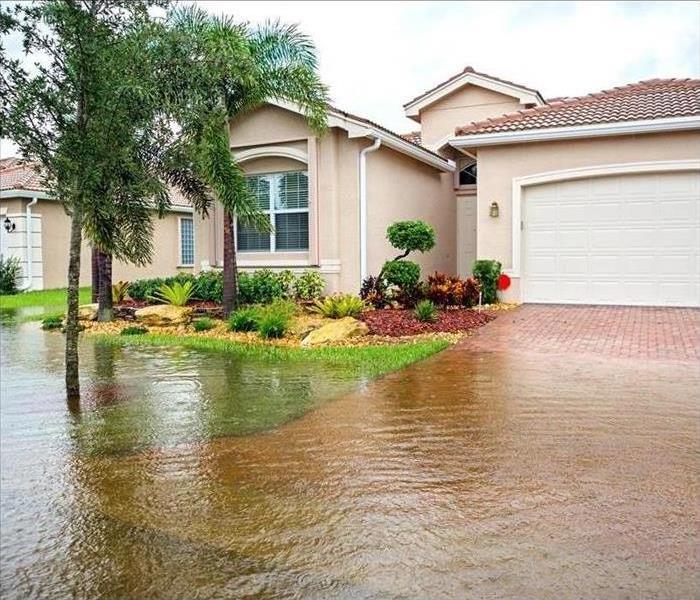 Call SERVPRO of Raytown/East Kansas City with any water damage restoration needs 816-737-8776
Call SERVPRO of Raytown/East Kansas City with any water damage restoration needs 816-737-8776
Flooded water in the home or water in the business needs to be handled immediately. The flooding could be as a result of a supply line break or a pipe break. Regardless of the cause water damage, restoration services need to be sought early. The first approach after a flooded home should be mitigation so as to prevent further flood damage. Water cleanup and drying services need to follow. Dealing water damage mitigation on your own can be overwhelming. Again, you may not have the necessary water cleanup tools to handle the flooded home or flood damage. When contemplating on whether to hire the services of a restoration company, home and business owners should consider the following benefits.
Prompt Restoration Services
When dealing with a flooded home, timing is everything. Your main concern should be to avoid secondary water damage. This is why you need to bring in a professional restoration company on board. They will conduct mitigation, water cleanup and drying services within a short span of time. This is because they have extensive experience in water damage restoration. These professionals will send multiple contractors to the site so as to get the work done in the shortest time possible. The restoration company will also get to the root cause of the water in the home or water in the business flood damage. If it is a supply line break or a pipe break, then they will fix it as well.
Mildew and Mold Growth Prevention
Flooded water and secondary water damage can provide a good breeding ground for mold and mildew. Flood damage mitigation professionals will conduct drying to avoid the growth of fungi and other harmful microorganisms. If mold is already present, the professionals will use grade cleaner and disinfectants to eliminate the mold. This will prevent mold exposure, which can affect your health.
Holistic Help
A Water restoration company will offer more than drying and water cleanup services. Their services are holistic and beneficial to the home or business owner. A flooded home comes with other issues that are subject to the flood damage. These professionals also offer additional services such as deodorization, vent cleaning, sanitation, and content restoration. Their main objective is to restore the home or business to its previous condition prior to water in the home or water in the business damage. These professionals will also take care of any supply line break or pipe break.
Reduced Drying Time
Reduced drying time is another advantage of hiring prompt services. This is made possible by quick water extraction methods. Water restoration experts have the necessary tools and skills to extract excess water, especially on carpets and drugs. They also get rid of standing water. These prompt services eliminate further loss and save the home or business owner. Fast water removal services are also important because mold spores can grow in 48 hours after a flood. Timing is therefore crucial for the success of the water removal process. Home and business owners can also salvage items such as carpets and furniture if the cleanup is done in good time.
Tips and Advice
Prevention is always safer as opposed to dealing with a flooded home. Once you have experienced a flood, you do not want to go through this again. Supply line breaks and a pipe break can be very expensive to repair. Leaking pipes have the potential to cause extensive water damage. This can even damage the structure of a building. It is prudent for home and business owners to conduct regular inspections of their supply lines.
Water removal professionals will also offer tips and advice and how to check for leaks. Common signs of water problems include wet carpets, drippings on the wall, exaggerated water bill and signs of rust. Prevention and mitigation strategies can help to avoid costly repairs after water in the home or water in the business damage. The effects of water can be mitigated by enlisting professional help in good time.
Shut Off Valves at Work
8/31/2017 (Permalink)
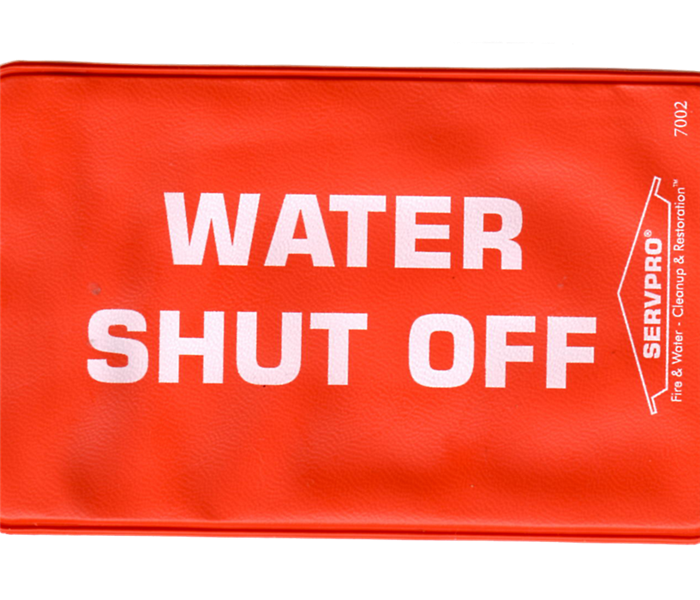 We also have shut off tags you can put on your water valves so they are easily noticeable.
We also have shut off tags you can put on your water valves so they are easily noticeable.
Many workplaces always call's on the boss or the maintenance man when something goes wrong. What if they were home sick, or in a meeting and you need to locate the water shut off, where do you start?
SERVPRO of Raytown/East Kansas City can help commercial property in planning for a water, fire, storm damage. How, with a free Emergency Response Profile created by the SERVPRO Marketing Department.
By having a plan of action and including it into your regular training at your office you can minimize the cost if an unplanned event happens like a frozen pipe, fire, or anything.
Some property manager use this as a tool to keep everything organized in one central location.
Is your business ready for a disaster. Even a simple pipe burst can cause a lot of damage and headache. With a SERVPRO® Emergency READY Profile it can have the critical information to minimize damages, provide the resources for the employee's of the company, and provide property details and information. This is a FREE services that we provide to commercial properties.
Make an appointment today to get started!
If the unthinkable happens, call your local SERVPRO of Lee's Summit Professionals at 816-737-8776 seven days a week 24/7 to help you avoid the cost and hassle of secondary damages. We will help make it "Like it never even happened."
The Steps We Take for the Cleanup of Water Damage
8/11/2017 (Permalink)
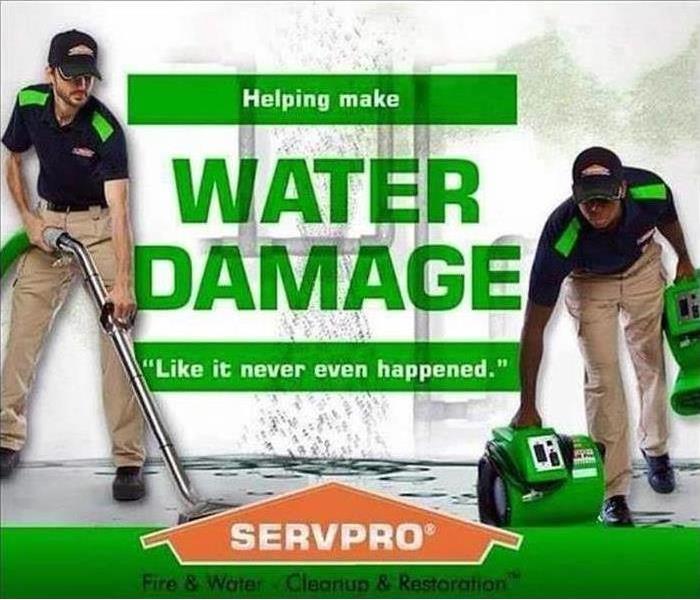 We are "Here To Help"
We are "Here To Help"
SERVPRO Handles the Entire Remediation Process
Water damage can come from many different sources, with varying intensities, danger levels, and reach of damage. Ultimately, many different objects, surfaces, and materials in a home can suffer water damage from the same event, and many homeowners question how a company such as SERVPRO handles a comprehensive water damage cleanup job. In this blog post, you'll learn about some of the ways our technicians control and repair water damage in local residences.
Identifying the Source and Water Type
Before all, water damage in Raytown/East Kansas City must be correctly defined by water type and source. Did it come from a storm or flood, or was it a pipe burst? There are also different types of water, typically categorized as either clean, gray, or black, each one with different safety and cleanup protocols. If necessary, our crew will work to stop the water flow as quickly as possible, to avert further damage to your home.
Surveying Damage and Mold
After we understand what type of damage we're dealing with, our technicians search the home visually and with moisture detection equipment to find out what objects have been affected, and what else needs to be done. Additionally, we look for signs of mold growth, which often takes priority in a cleanup operation.
Furniture and Water Removal
The next step is to remove all furniture from affected areas, and then pump out water if necessary. We use industrial-grade machinery to pump water from the interior to the exterior of the home, with either a portable or a truck-mounted pump.
Drying and Odor Treatments
At this point, we bring out more heavy machinery to begin drying and deodorizing the affected area, to make sure no more damage or mold growth occurs and any bad smells are removed.
Carpet Removal and Final Cleaning
In many cases, some or all of the carpeting in a room will need replacing. We make sure to evaluate carpeting carefully for moisture so as not to incur extra expenses. Sometimes, a cleaning may only be necessary, particularly when water damage is contained early on. After that is done, final cleanup and sanitization are done on walls and objects, and furniture is brought back into the home or rooms affected.
SERVPRO of Raytown/East Kansas City employs certified and well-trained technicians who are experienced with all kinds of water damage restoration and cleanup jobs. If you need our services for any type or volume of water damage to your home, call us at 816-737-8776 for 24/7 emergency service.
Water Damage Restoration Tips For Your House After A Flood
7/3/2017 (Permalink)
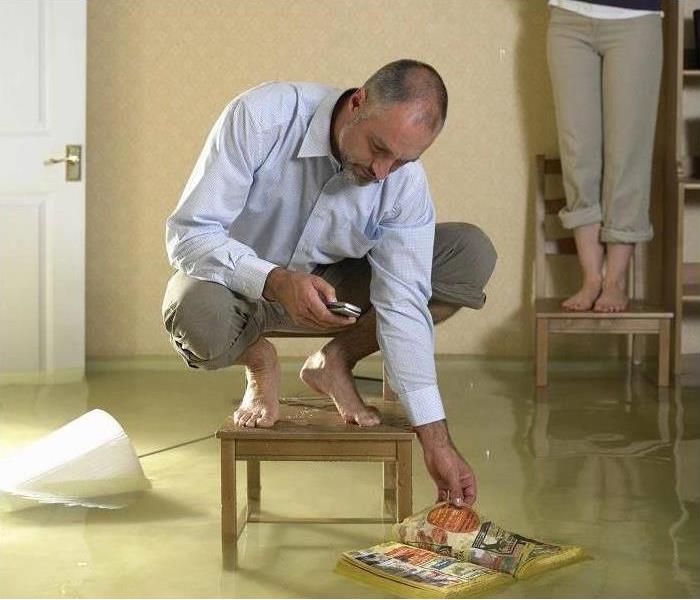 Contact SERVPRO of Raytown / East Kansas City today to be prepared for when natural disasters like this strike near you.
Contact SERVPRO of Raytown / East Kansas City today to be prepared for when natural disasters like this strike near you.
Water Damage Restoration Tips For Your House After A Flood
A few years back, homes, business properties and personal items devastated by flood water were considered lost. Today, with innovations in technology, the losses due to flood damage can now be restored to their former state. The process is not easy, it requires extensive mopping up and drying of the property after a severe water damage.
Flood water in home or business can damage your walls, floors, carpets and other personal belongings too. Extracting the water is impossible without proper equipment while sun drying does not guarantee your assets' restoration to their former state before the incident. There is also an additional risk the water in the home might have damaged electrical equipment or wires. Anyone tampering with either could be in for a horrible electrocution during the water cleanup and restoration.
For these reasons, water cleanup and restoration is best handled by professionals. They have to requisite experience, state-of-the-art equipment and techniques to do the job properly and offer mitigation against further damage. If the renovation job requires extensive work, promptness in beginning the works is paramount. The less the time-frame between flood damage and refurbishment, the greater the ease of reinstating a property or item to its preloss state. There are four fundamental steps to follow with any renovation job after a water damage:
- Removal of the Flood Water
The first important step to restoring a property after damaging from water in home or business premise is removing the stagnant water. Often, a submersible pump is used to remove the water accumulation in various structures around the premises.
2. Moisture Mapping
It is crucial to get an idea of the extent of water damage and take the first mitigation steps against mold growth. The step uses detection equipment to obtain and appropriately map the moisture values on the property. Properly trained technicians use infrared and digital imaging to determine the damage extent.
3. Mold Inspection and Removal
After moisture mapping, the house will need to be prepared to repel mold and mildew. Any residual stagnant water in business or homestead leads to a favorable habitat for the fungi to thrive thus mitigation against it is essential. Water cleanup professionals make use of special detergents to sterilize the area and make the surroundings unfavorable for mold growth. Some renovation firms take advantage of deodorization and ventilation during this step to remove any airborne contaminants and lingering, unpleasant odors.
4. Water Drying
This last step ensures the property is completely dry and humidity is brought back to its normal state after flood damage. There are various water drying techniques and the one used will depend on the situation’s severity. These techniques include:
- Air Movers- They help dry the establishment by controlling humidity and promoting air circulation. Working in sections, the air movers remove liquids from all porous materials including carpets and wood. Any remaining water in home or business premises is left for more sophisticated machines.
- Dehumidifiers- They remove moisture form the air and help extract any remaining water in business or home environment. Broadly, professional use either desiccant or refrigerant dehumidifier. Desiccant dehumidifiers operate by cooling the air to make it reduce its ability to retain water. As a result, condensation occurs around the equipment’s cooling coils. Applying these machines on a large scale promptly extracts excess humidity from the air leaving no more water in business or household and thus no further water damage. The particular type of equipment, however, depends on the tired company and how extensive the restoration job is.
With the right professionals, a successful water cleanup is possible, and any damage from water in business or home establishment can be fixed. Each job, however, is unique and requires prompt, proper investigation. This helps come up with a plan based on the steps above to restore the property after water damage. Visit http://www.SERVPROraytowneastkansascity.com/water-damage-restoration for more information on water damage.





 24/7 Emergency Service
24/7 Emergency Service








